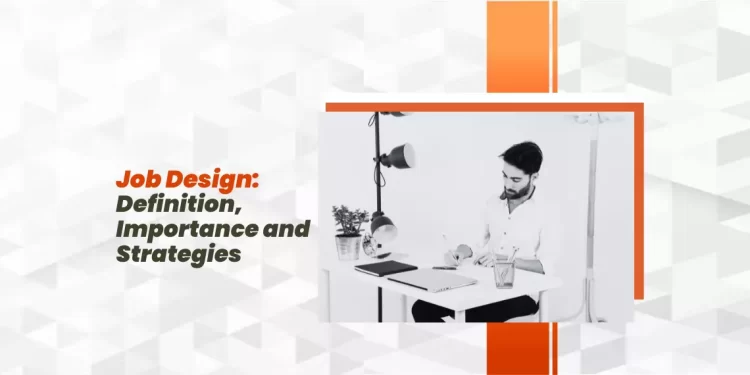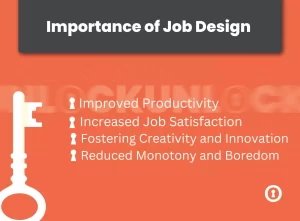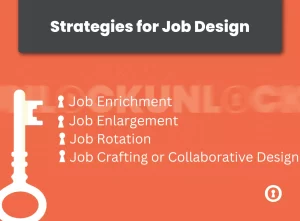

Due to the dynamic nature of the market and the business world, there is a constant need for change within companies. One cannot go on with the same old jobs and roles that have existed for the past decade or more. This is where the concept of job design enters.
Job design refers to the process of structuring and shaping various components of a job to optimize the performance and satisfaction of the employees, contributing to organization’s success. It can also mean to generate and design new jobs based on the demands of an organization. By crafting roles that suit the capabilities of employees and meet the organizational goals, job design boosts productivity and satisfaction.
Let’s take as an example the role of a project manager. Suppose you want to implement the concept of job design for this role. You can do it by expanding their responsibilities to include client relationship management, in addition to their original duty of project planning and execution. This change can allow a project manager to have a more comprehensive impact on the project’s success.
In order to better understand the concept of job design, let’s explore the elements that make up job design:
Define the specific tasks and responsibilities that make up the role of an employee. Make sure that the tasks have variety, mixing the monotonous with the engaging.
Assign tasks that make the employee feel a sense of accomplishment when they complete it. They should be able to see a tangible outcome for their efforts.
Ideally, when designing a job, remember to incorporate tasks that involve a variety of skills and not just technical job-specific ones.
Another thing that is essential to job design is a sense of control an employee should have in their new role. Provide employees with decision making authority and basic autonomy to let them take ownership of their tasks.
Another crucial element of job design is to establish a mechanism which makes feedback on job performance possible.

If you have designed a job that fits well with the organization’s needs and also caters to the developmental needs of an employee, it would reduce a lot of potential bottlenecks, thus increasing productivity. By optimizing workflows and streamlining tasks to only the ones that matter, a lot of time is saved which can be put to better use by employees.
Good job design increases the job satisfaction of the employees, as the newly designed job caters to their needs and capacities. This increased job satisfaction translates into good performance from them, contributing to the organization’s success.
Job design that bears in mind the creative need of employees, and encourages it, can be a great driver of innovation. When roles demand creative problem solving from the employees, the organization can tap into the workforce’s potential for innovation.
Jobs that are designed to encourage the flowering of various faculties in an employee are generally more engaging and provide enough challenge to not let the work become monotonous. This helps the employee to remain enthusiastic about their work.

Following are some of the best strategies of job design that can be used in the workplace to improve productivity, and job satisfaction:
You can enhance jobs by the addition of more meaningful tasks which require active engagement from the employee. This would challenge them to grow and is a great strategy for job design. For example, a data analyst could be asked to identify broad trends and patterns in the data they analyze, helping the company in strategic decisions.
Job enlargement can be done by adding tasks that are at a similar skill level for the employee, but provides variety. This would eliminate any potential monotony. For example, a graphic designer can be asked for inputs in the whole marketing campaign, and not just limit him to creating visuals.
You can also rotate employees through different roles within the organization in order to help them gain diverse experience, while also giving them opportunities to enhance their skills. For example, an employee in the finance department can move to the marketing department for a period of time, thus gaining insights into different aspects of the business.
You can allow employees to give their inputs on the design of jobs they want , customizing the role according to their strengths and developmental needs. For example, a content writer can ask to take on more research-based writing tasks in order to upskill in that particular area.
If you are a new manager who is looking to improve their managerial skills but can’t invest too much time searching around for resources, then DT Evolve has a course for you. It’s difficult to be a manager, especially if you’re having trouble influencing those around you, both above and below you. This course aids the process of learning to be influential and understanding how successful managers influence those around them, including your team members, peers, and even your bosses. With this course, you will be well on your way to a successful management career in no time. Here’s the link to the course, Must Have Skills for a Manager.
In this blog, we tried to explore the concept of job design, introducing it first with a definition and an example. We looked into the elements that make up the process of job design, and these included task identity, skill variety, autonomy, feedback and so on. We then explored the importance of job design, how good job design improves productivity, increases job satisfaction, fosters creativity and reduces monotony and boredom. Lastly we talked about effective strategies for job design like job enrichment, job enlargement and so on.